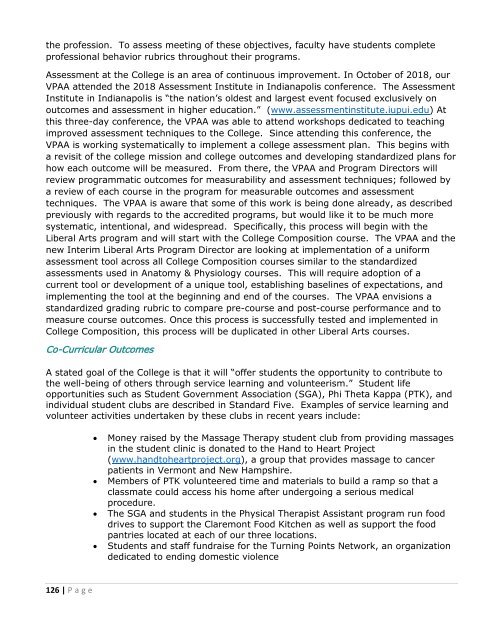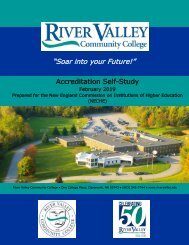You also want an ePaper? Increase the reach of your titles
YUMPU automatically turns print PDFs into web optimized ePapers that Google loves.
the profession. To assess meeting of these objectives, faculty have students complete<br />
professional behavior rubrics throughout their programs.<br />
Assessment at the College is an area of continuous improvement. In October of 2018, our<br />
VPAA attended the 2018 Assessment Institute in Indianapolis conference. The Assessment<br />
Institute in Indianapolis is “the nation’s oldest and largest event focused exclusively on<br />
outcomes and assessment in higher education.” (www.assessmentinstitute.iupui.edu) At<br />
this three-day conference, the VPAA was able to attend workshops dedicated to teaching<br />
improved assessment techniques to the College. Since attending this conference, the<br />
VPAA is working systematically to implement a college assessment plan. This begins with<br />
a revisit of the college mission and college outcomes and developing standardized plans for<br />
how each outcome will be measured. From there, the VPAA and Program Directors will<br />
review programmatic outcomes for measurability and assessment techniques; followed by<br />
a review of each course in the program for measurable outcomes and assessment<br />
techniques. The VPAA is aware that some of this work is being done already, as described<br />
previously with regards to the accredited programs, but would like it to be much more<br />
systematic, intentional, and widespread. Specifically, this process will begin with the<br />
Liberal Arts program and will start with the College Composition course. The VPAA and the<br />
new Interim Liberal Arts Program Director are looking at implementation of a uniform<br />
assessment tool across all College Composition courses similar to the standardized<br />
assessments used in Anatomy & Physiology courses. This will require adoption of a<br />
current tool or development of a unique tool, establishing baselines of expectations, and<br />
implementing the tool at the beginning and end of the courses. The VPAA envisions a<br />
standardized grading rubric to compare pre-course and post-course performance and to<br />
measure course outcomes. Once this process is successfully tested and implemented in<br />
College Composition, this process will be duplicated in other Liberal Arts courses.<br />
Co-Curricular Outcomes<br />
A stated goal of the College is that it will “offer students the opportunity to contribute to<br />
the well-being of others through service learning and volunteerism.” Student life<br />
opportunities such as Student Government Association (SGA), Phi Theta Kappa (PTK), and<br />
individual student clubs are described in Standard Five. Examples of service learning and<br />
volunteer activities undertaken by these clubs in recent years include:<br />
<br />
<br />
<br />
<br />
Money raised by the Massage Therapy student club from providing massages<br />
in the student clinic is donated to the Hand to Heart Project<br />
(www.handtoheartproject.org), a group that provides massage to cancer<br />
patients in Vermont and New Hampshire.<br />
Members of PTK volunteered time and materials to build a ramp so that a<br />
classmate could access his home after undergoing a serious medical<br />
procedure.<br />
The SGA and students in the Physical Therapist Assistant program run food<br />
drives to support the Claremont Food Kitchen as well as support the food<br />
pantries located at each of our three locations.<br />
Students and staff fundraise for the Turning Points Network, an organization<br />
dedicated to ending domestic violence<br />
126 | P a g e





